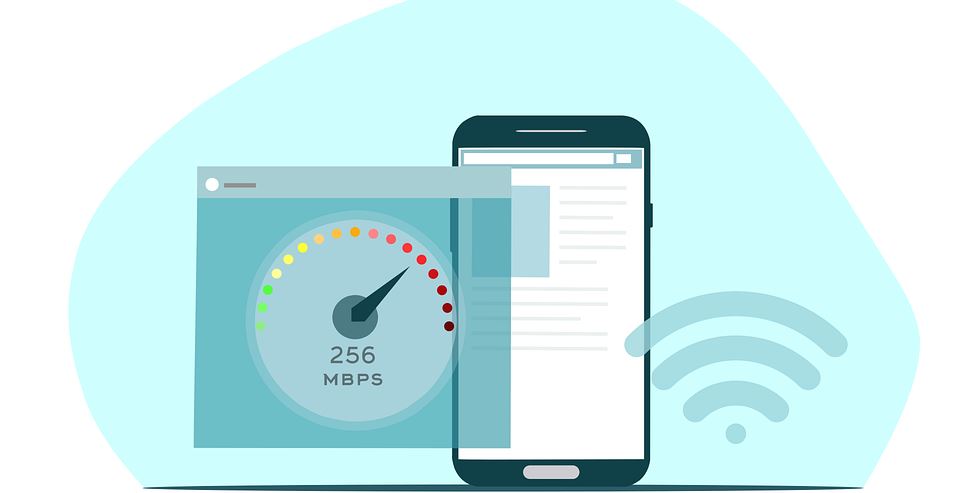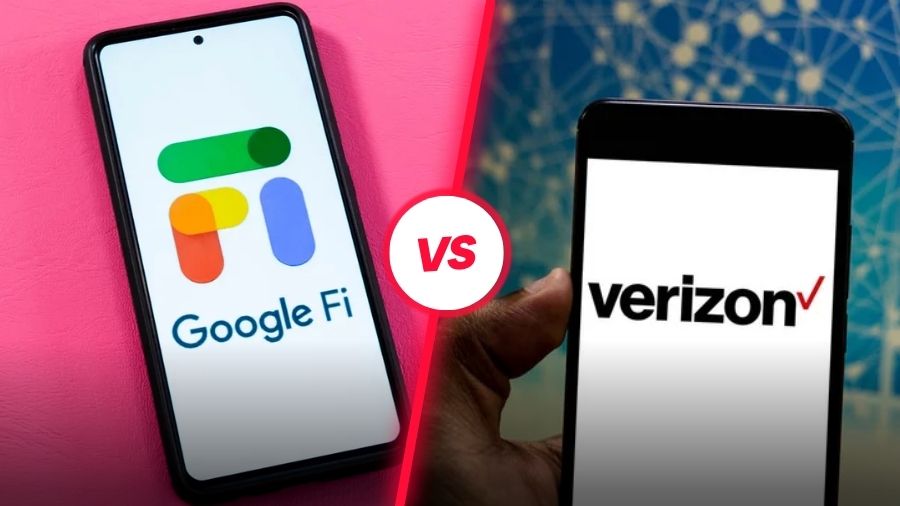Looking for a detailed comparison guide on Google Fi vs. Verizon? If yes, you have stumbled upon the right webpage.
In this article, we have thoroughly compared Google Fi and Verizon so that you can decide which one of these two services will be the perfect fit for you.
So, without any further ado, let’s get started –
Google Fi vs. Verizon 2023: Which one is right for you?
Google Fi is a Mobile Virtual Network Operator (MVNO), meaning it does not use its network. Instead, it relies on T-Mobile and Three’s networks to provide coverage to its customers.
On the other hand, Verizon is the largest network operator in the United States, with around 145 million subscribers. It is one of the most trusted providers due to its extensive coverage and network reliability.
Let’s compare Google Fi vs. Verizon on important factors to learn more about these carriers –
Google Fi vs. Verizon – Pricing

If we compare Google Fi vs. Verizon based on the pricing of their plans, Verizon is a bit more expensive. You are likely to spend $5-$10 more monthly for an unlimited plan on the Verizon network compared to Google Fi.
Below we have mentioned the price details of these carriers depending on the unlimited plans and number of lines –
For Entry-level Unlimited Plan
Verizon costs – Start Unlimited Plan
- $70 for one line
- $60 per line for 2 lines
- $45 per line for 3 lines
- $35 per line for 4 lines
Google Fi costs –
- $60 for single line
- $45 per line for two lines
- $30 per line for three lines
- $30 per line for four lines
Mid-level Unlimited Plan
Verizon costs – Do More Unlimited Plan
- $80 for single line
- $70 per line for two lines
- $55 per line for three lines
- $45 per line for four lines
Google Fi costs – Unlimited Plus
- $70 for one line
- $60 per line for two lines
- $50 per line for three lines
- $45 per line for four lines
By examining the figures, you can see that Google Fi’s Unlimited Plus option is similar to Verizon’s Start Unlimited Plan.
However, the Start Unlimited Plan of Verizon costs $35 per line with 4 lines in contrast to $30 per line offered by Google Fi plan for 4 or more lines. If you move to one of Verizon’s mid-level unlimited plans, you will notice an expensive bill. Nonetheless, Verizon’s expensive plans have more perks with it.
Besides that, Google Fi also offers a Flexible Plan, starting at $20 monthly for a single line and $10 for each gigabyte of data you use. It is one of Google Fi’s most affordable plans. In addition, Google Fi offers bill protection to its customers.
Google Fi vs. Verizon – Perks and Promotions
If we look at Google vs. Verizon based on perks and promotions, Verizon Wireless has the edge over Google Fi. The provider has several attractive perks with its costly plans.
According to the plans, some of Verizon and Google Fi’s perks are discussed below –
Verizon Start Unlimited Plan
- Discovery Plus for 1 year
- Disney Plus & Apple Music for 6 months
Verizon Play More Unlimited Plan
- Disney Plus, ESPN Plus, and Hulu included
- Discovery Plus for 1 year
- Apple Music for 6 months
Verizon Do More Unlimited Plan
- Discovery Plus for 1 year
- Disney Plus & Apple Music for 6 months
Verizon Get More Unlimited Plan
- Disney Plus, ESPN Plus, Hulu, and Apple Music
- Discovery Plus for 12 months
Google Fi Unlimited Plan
- Google One membership
Verizon is truly a great option for people looking for additional perks. Verizon offers a subscription to Apple Music and Disney Plus bundled with its bundled service. Its Get, More Unlimited Plan has both services permanently. Verizon’s unlimited plans can offer you up to one year of Discovery Plus, Google Play Pass, or Apple Arcade.
In contrast, if we look at Google Fi, it has only Google One Membership with its Google Fi Unlimited Plus Plan. Its Flexible and Simply Unlimited Plans provide only bill protection benefits for heavy data users.
Verizon wins over Google Fi in terms of promotions too. When you switch to Google Fi, you can get some savings on a few specific devices like the Galaxy S22 family. You can sign up for a Pixel Pass and get a Pixel 7. But you only have a few devices to choose from. On the flip side, Verizon has ample options when you switch to its network. You can get a Galaxy S22 and a Pixel 7 free when you trade in with the old eligible device.
Google Fi vs. Verizon – High-Speed Data

For Google Fi, data plans are as follows –
| Plans | Data |
| Flexible | 15 GB |
| Simply Unlimited | 35 GB |
| Unlimited Plus | 50 GB |
For Verizon, data plans are as follows –
| Plans | Data |
| 5G Start | None |
| 5G Do More | 50 GB |
| 5G Play More | 50 GB |
| 5G Get More | Unlimited |
Verizon provides more plans with high-speed data that keeps up when you exceed the 5G Get More Tier Plan limit. Verizon’s mid-range 5G Do More Play More packages resemble Google Fi’s top Unlimited Plus Plan. Overall, Verizon wins over Google Fi in high-speed data respect with multiple 50 GB premium access options and a truly unlimited option.
Google Fi vs. Verizon – Mobile Hotspot Data
Mobile hotspot data enables you to use the internet on your laptop or tablet through your phone’s hotspot.
For Google Fi, hotspot plans are as follows –
| Plans | Hotspot |
| Flexible | $10/GB |
| Simply Unlimited | 5 GB |
| Unlimited Plus | 50 GB |
Hotspot plans offered by Verizon are as follows –
| Plans | Hotspot |
| 5G Start | 5 GB |
| 5G Do More | 25 GB |
| 5G Play More | 25 GB |
| 5G Get More | 50 GB |
From the information above, you can understand that Google Fi and Verizon provide you with up to 50 GB of mobile hotspot data. Verizon offers multiple plans with a 25 GB monthly hotspot.
Google Fi vs. Verizon – Phone selections
Verizon provides a huge selection of phones, ranging from the latest iPhones and Galaxy S series to Motorola’s budget-friendly gadgets. Verizon is the only carrier after Google Fi to provide Google’s Pixel phones.
In contrast, Google Fi provides only six models of phones, the Pixel series, Moto G6 and X4, LG V35 ThinQ, and G7 ThinQ. These phones work only on Google Fi’s network.
Google Fi vs. Verizon – Family Plans
Family plans allow you to get a discount on adding multiple lines. Both Google Fi and Verizon offer adding lines for additional savings.
Family plans offered by Google Fi –
| Plans | Single Line Cost | Four Lines Cost |
| Flexible | $20/month |
$68/month at $17 per line
|
| Simply Unlimited | $50/month |
$80/month at $20 per line
|
| Unlimited Plus | $65/month |
$160/month at $40 per line
|
Family plans offered by Verizon –
| Plans | Single Line Cost | Four Lines Cost |
| 5G Start | $70/month |
$140/month at $35 per line
|
| 5G Play More | $80/month |
$180/month at $45 per line
|
| 5G Do More | $80/month |
$180/month at $45 per line
|
| 5G Get More | $90/month |
$220/month at $55 per line
|
The information shows that Verizon’s four-line family plan prices are higher than Google Fi’s. But Verizon provides more perks and benefits that may be worth the expense. Therefore, if you evaluate Google Fi vs. Verizon on family plans, choosing the ideal carrier will depend on whether you consider price or perks as your priority.
If you are considering saving on your family plan, you better choose Google Fi’s plans, and if you wish to add more perks to your plans, you may switch to Verizon.
Google Fi vs. Verizon – Unlimited Plans
Google Fi has a simple plan. It offers only one unlimited plan, which costs $20 per line with unlimited talk and text. The data in the plan costs $10 per gigabyte.
When you use Google Fi’s unlimited Plan, you enter how much data you expect to use at the beginning of every monthly billing cycle. If you cross the limit, Google will credit you for anything under your entered limit or charge you on your following bill. The charge rate is always the same, $1 per 100 MB.
Google Fi also provides Bill Protection which prevents you from paying extra charges once you cross 6 GB of data. The data charges stop at $60, making the Plan effectively unlimited. This means that Google Fi’s monthly phone bill can be less expensive than Verizon’s basic plan. However, it is important to note that once you exceed 15 GB, Google Fi slows down your data speed.
In comparison, Verizon has a more complicated unlimited plan structure. The company generally has three data plans, 2GB, 4 GB, and 8 GB. These plans can be used individually or shared with any family member. These data plans cost $35, $50, and $70 monthly, excluding the takes and extra charges.
These plans allow you to carry over the remaining data you do not use into the next month. But if you exceed the data limit, you must pay overage fees. However, you can save overage charges if you switch to Safety Mode, which reduces your data speed after exceeding the limit.
Google Fi vs. Verizon – Customer Service

Customer service is an important aspect to consider when choosing a service provider since reliable customer service is essential to solving your issue.
If we look at Google Fi vs. Verizon regarding customer service, both carriers have good customer service. Google Fi offers transparent customer service through its well-designed application. The app provides easier chat via email, texts, or phone with a supportive company representative and enables you to solve your problems effortlessly.
The app displays the expected waiting time before connecting to any customer care executive. It helps you to change everything you wish, from setting data-usage warnings to viewing your billing records. Google Fi application basis customer service is one of the most convenient services among wireless carriers.
Verizon’s website is a good resource for asking questions as the company provides several options to connect to its customer care service. Verizon is also considered one of the most responsive customer service among the top wireless service providers in the country.
Google vs. Verizon – Network Coverage
Looking at Google Fi vs. Verizon more closely for network coverage, Verizon’s network is the largest, covering 70% of the country. It provides a reliable network nationwide, and it is one of the reasons for its preference by most people.
Google Fi is MVNO and uses three carrier networks to offer services to its customers. T-Mobile is one of the three networks that Google Fi uses and is the second big four carriers, making 59% in the country. The second network Google Fi uses is Sprint, covering 27% of the country, and the third carrier Google Fi uses US Cellular. Therefore, if you use Google Fi, your phone will automatically pick up the network amongst the three having the best coverage in your area.
Verizon has great network coverage for 4G LTE, but its 5G network coverage needs improvement since it is unreliable. In comparison, Google Fi offers decent 5G connectivity. However, Verizon’s network has few advantages over Google Fi’s, especially regarding speed and availability in rural areas.
Which carrier is right for you?
We have considered many factors of comparison between Google Fi vs. Verizon. The answer to this question entirely depends on your needs.
Verizon is an expensive service provider but offers a good network with extensive mobile phone options. The company also has several benefits and perks with unlimited plans. You might get a few of the perks if you need a cheap plan from Verizon. Verizon is a good option when you can afford little high phone bills and wish to have many perks and unlimited plans.
With Google Fi, you will get only two plans and a small phone selection. Google Fi uses T-Mobile and US Cellular networks, which is a good option if you are a frequent traveler abroad. Google Fi and Verizon have compatible packs, depending on your location, phone, data plan, and travel itinerary. Hence, it would be best to consider your needs and select the right carrier.
Frequently Asked Questions
Does Verizon offer better coverage than Google Fi?
Verizon offers better 4G LTE and rural coverage, but Google Fi has better 5G coverage.
Is it worth switching to Google Fi?
Yes. It is good switching to Google Fi for its good 5G connectivity, dual network coverage, and availability of affordable plans.
Which carrier is less expensive, Google Fi or Verizon?
Verizon is an expensive provider. Its plans are costlier than Google Fi’s unlimited plans. However, the Verizon Unlimited plans offer some additional perks. In contrast, Google Fi offers reasonable plans with fewer perks.
How is Verizon’s 5G coverage?
Verizon offers reliable 4G LTE coverage, covering 70% of the United States. However, its 5G network needs improvements and is less decent than its 4G services.







Add Comment